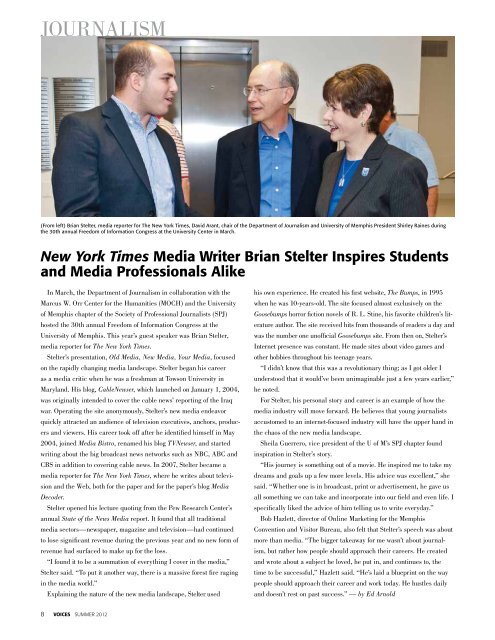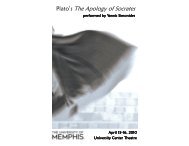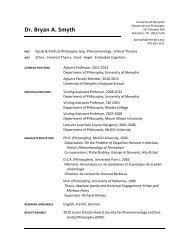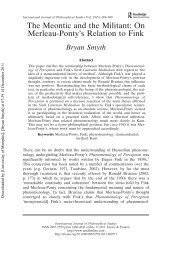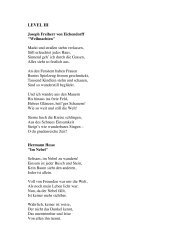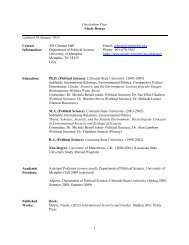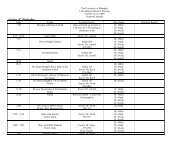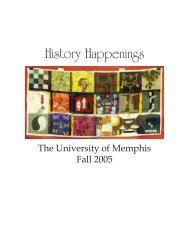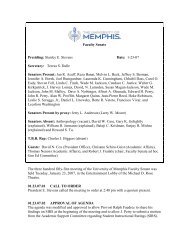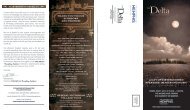Alma Mater - University of Memphis
Alma Mater - University of Memphis
Alma Mater - University of Memphis
You also want an ePaper? Increase the reach of your titles
YUMPU automatically turns print PDFs into web optimized ePapers that Google loves.
JOURNALISM<br />
(From left) Brian Stelter, media reporter for The New York Times, David Arant, chair <strong>of</strong> the Department <strong>of</strong> Journalism and <strong>University</strong> <strong>of</strong> <strong>Memphis</strong> President Shirley Raines during<br />
the 30th annual Freedom <strong>of</strong> Information Congress at the <strong>University</strong> Center in March.<br />
New York Times Media Writer Brian Stelter Inspires Students<br />
and Media Pr<strong>of</strong>essionals Alike<br />
8<br />
In March, the Department <strong>of</strong> Journalism in collaboration with the<br />
Marcus W. Orr Center for the Humanities (MOCH) and the <strong>University</strong><br />
<strong>of</strong> <strong>Memphis</strong> chapter <strong>of</strong> the Society <strong>of</strong> Pr<strong>of</strong>essional Journalists (SPJ)<br />
hosted the 30th annual Freedom <strong>of</strong> Information Congress at the<br />
<strong>University</strong> <strong>of</strong> <strong>Memphis</strong>. This year’s guest speaker was Brian Stelter,<br />
media reporter for The New York Times.<br />
Stelter’s presentation, Old Media, New Media, Your Media, focused<br />
on the rapidly changing media landscape. Stelter began his career<br />
as a media critic when he was a freshman at Towson <strong>University</strong> in<br />
Maryland. His blog, CableNewser, which launched on January 1, 2004,<br />
was originally intended to cover the cable news’ reporting <strong>of</strong> the Iraq<br />
war. Operating the site anonymously, Stelter’s new media endeavor<br />
quickly attracted an audience <strong>of</strong> television executives, anchors, produc-<br />
ers and viewers. His career took <strong>of</strong>f after he identified himself in May<br />
2004, joined Media Bistro, renamed his blog TVNewser, and started<br />
writing about the big broadcast news networks such as NBC, ABC and<br />
CBS in addition to covering cable news. In 2007, Stelter became a<br />
media reporter for The New York Times, where he writes about televi-<br />
sion and the Web, both for the paper and for the paper’s blog Media<br />
Decoder.<br />
Stelter opened his lecture quoting from the Pew Research Center’s<br />
annual State <strong>of</strong> the News Media report. It found that all traditional<br />
media sectors—newspaper, magazine and television—had continued<br />
to lose significant revenue during the previous year and no new form <strong>of</strong><br />
revenue had surfaced to make up for the loss.<br />
“I found it to be a summation <strong>of</strong> everything I cover in the media,”<br />
Stelter said. “To put it another way, there is a massive forest fire raging<br />
in the media world.”<br />
Explaining the nature <strong>of</strong> the new media landscape, Stelter used<br />
VOICES SUMMER 2012<br />
his own experience. He created his first website, The Bumps, in 1995<br />
when he was 10-years-old. The site focused almost exclusively on the<br />
Goosebumps horror fiction novels <strong>of</strong> R. L. Stine, his favorite children’s lit-<br />
erature author. The site received hits from thousands <strong>of</strong> readers a day and<br />
was the number one un<strong>of</strong>ficial Goosebumps site. From then on, Stelter’s<br />
Internet presence was constant. He made sites about video games and<br />
other hobbies throughout his teenage years.<br />
“I didn’t know that this was a revolutionary thing; as I got older I<br />
understood that it would’ve been unimaginable just a few years earlier,”<br />
he noted.<br />
For Stelter, his personal story and career is an example <strong>of</strong> how the<br />
media industry will move forward. He believes that young journalists<br />
accustomed to an internet-focused industry will have the upper hand in<br />
the chaos <strong>of</strong> the new media landscape.<br />
Sheila Guerrero, vice president <strong>of</strong> the U <strong>of</strong> M’s SPJ chapter found<br />
inspiration in Stelter’s story.<br />
“His journey is something out <strong>of</strong> a movie. He inspired me to take my<br />
dreams and goals up a few more levels. His advice was excellent,” she<br />
said. “Whether one is in broadcast, print or advertisement, he gave us<br />
all something we can take and incorporate into our field and even life. I<br />
specifically liked the advice <strong>of</strong> him telling us to write everyday.”<br />
Bob Hazlett, director <strong>of</strong> Online Marketing for the <strong>Memphis</strong><br />
Convention and Visitor Bureau, also felt that Stelter’s speech was about<br />
more than media. “The bigger takeaway for me wasn’t about journal-<br />
ism, but rather how people should approach their careers. He created<br />
and wrote about a subject he loved, he put in, and continues to, the<br />
time to be successful,” Hazlett said. “He’s laid a blueprint on the way<br />
people should approach their career and work today. He hustles daily<br />
and doesn’t rest on past success.” — by Ed Arnold


